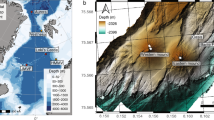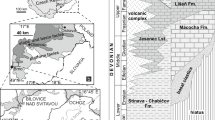Abstract
Recent suggestions that the Miocene-age “calcari aLucina” blocks scattered in the Apennine chain of the Italian peninsula are methanogenic in nature (paleo cold vents) calls for a reexamination of their macrofauna. Two Tortonian-age outcrops of such limestones (Case Rovereti and Montepetra) have been analyzed for their mollusk content and shown to host a diverse vent fauna. The paleoassemblages show remarkable similarities with modern counterparts associated with hydrocarbon venting on the Gulf of Mexico continental slope. Faunal data from both sites lend support to the hypothesis that methane/hydrocarbon venting was active during the Miocene and sustained specialized bathyal chemosynthetic communities in the ancient Mediterranean.
Similar content being viewed by others
References
Aharon P, Terzi C, Ricci-Lucchi F, Vai GB, and Taviani M (1993) A fossil record of hydrocarbon and fluid venting imprinted in the Miocene-ageLucina limestones of the Northern Apennines, Italy. American Association of Petroleum Geologists Annual Convention Program with Abstracts, New Orleans p 66
Beauchamp B and Savard M (1992) Cretaceous chemosynthetic carbonate mounds in the Canadian Arctic. Palaios 7(4):434–450
Brooks JM, Kennicutt II MC, Fisher CR, Macko SA, Cole K, Childress JJ, Bidigare RR, and Vetter RD (1987) Deep-sea hydrocarbon seep communities: Evidence for energy and nutrional carbon sources. Science 238:1138–1142
Callender RW and Powell EN (1992) Taphonomic signature of petroleum seep assemblages on the Louisiana upper continental slope: Recognition of autochtonous shell beds in the fossil record. Palaios 7:388–408
Callender RW, Staff G, Powell E, and MacDonald IR (1990) Gulf of Mexico hydrocarbon seep communities V. Biofacies and shell orientation of autochtonous shell beds below storm wave base. Palaios 5:2–14
Campbell KA (1992) Recognition of a Mio-Pliocene cold seep setting from the northeast Pacific convergent margin, Washington, USA. Palaios 7(4):422–433
Cary SC, Vetter RD, and Felbeck H (1989) Habitat characterization and nutritional strategies of the endosymbiont-bearing bivalveLucinoma aequizonata. Marine Ecology Progress Series 55:31–45
Clari P, Gagliardi C. Governa ME, Ricci B, and Zuppi GM (1988) I Calcari di Marmorito: Una testimonianza di processi diagenetici in presenza di metano. Bollettino del Museo Regionale di Scienze Naturali, Torino 6:197–216
Felbeck H, Childress JJ, and Somero GN (1981) Calvin-Benson cycle and sulfide oxidation enzymes in animals from sulfide-rich habitats. Nature 293:291–293
Fiala-Medoni A and Le Pennec M (1989) Adaptive features of the bivalve molluscs associated with fluid venting in the subduction zones off Japan. Palaeogeography, Palaeoclimatology, Palaeoecology 71:161–167
Fisher CR (1990) Chemoautotrophic and thenaotrophic symbioses in marine invertebrates. Reviews in Aquatic Sciences 2:399–436
Fisher CR, Childress JJ, Oremland RS, and Bidigare RR (1987) The importance of methane and thiosulphate in the metabolism of the bacterial symbionts of two deep-sea mussels. Marine Biology 96:59–71
Gage JD and Tyler PA (1991) Deep-Sea Biology. Cambridge: Cambridge University Press 504 pp
Gaillard C, Rio M, Rolin Y, and Roux M (1992) Fossil chemosynthetic communities related to vents or seeps in sedimentary basins: The pseudobioherms of southeastern France compared to other world examples. Palaios 7(4):451–465
Goedert JL and Squires RL (1990) Eocene deep-sea communities in localized limestones formed by subduction-related methane seeps, southwestern Washington. Geology 18:1182–1185
Hashimoto J, Ohta S, Tanaka T, Hotta H, Matsuzawa S, and Sakai H (1989) Deep-sea communities dominated by the giant clam,Calyptogena soyoae. along the slope foot of Hatsushima island, Sagami Bay, Central Japan. Palaeogeography, Palaeoclimatology, Palaeoecology 71:179–192
Hovland M, Talbot MR, Qvale H, Olaussen S, and Aasberg L (1987) Methane-related carbonate cements in pockmarks of the North Sea. Journal of Sedimentary Petrology 57(5):881–892
Kennicutt MC II, Brooks JM, Bidigare RR, Fay RR, Wade TL, and McDonald TJ (1985) Vent-type taxa in a hydrocarbon seep region on the Louisiana slope. Nature 317:351–353
Lonsdale PF (1977) Clustering of suspension-feeding macrobenthos near abyssal hydrothermal vents at oceanic spreading centers. Deep-Sea Research 24:857–863
Lutz RA, Bouchet P, Jablonski D, Turner RD, and Waren A (1986) Larval ecology of mollusks at deep-sea hydrothermal vents. American Malacological Bulletin 41(1):49–54
MacDonald IR, Boland GS, Baker JS, Brooks JM, Kennicutt MC II, and Bidigare RR (1989) Gulf of Mexico hydrocarbon seep communities. II. Spatial distribution of seep organisms and hydrocarbons at Bush Hill. Marine Biology 101:235–247
Moroni MA (1966) Malacofauna del “Calcare a Lucine” di S. Sofia, Forli'. Palaeontographia Italica 60:69–87
Nitsuma M, Matsushima Y, and Hirata D (1989) Abyssal molluscan colony ofCalyptogena in the Pliocene strata of the Miura peninsula, Central Japan. Palaeogeography, Palaeoclimatology, Palaeoecology 71:193–203
Okutani T and Egawa K (1985) The first underwater observation on living habit and thanatocoenoses ofCalyptogena soyoae in bathyal depth of Sagami Bay. Venus 44:285–289
Reid RGB and Brand DG (1986) Sulfide-oxidizing symbiosis in lucinaceans: Implications for bivalve evolution. The Veliger 29:3–24
Ricci Lucchi F and D'Onofrio S (1967) Trasporti gravitativi sinsedimentari nel Tortoniano dell'Appennino Romagnolo (Valle del Savio) Giornale di Geologia, ser. 2 34(1):1–30
Ricci Lucchi F and Vai GB (1994) A stratigraphic and tectonofacies framework of the “calcari aLucina” in the Apennine Chain, Italy. Geo-Marine Letters 14:210–218
Ricci Lucchi F and Veggiani A (1967) I calcari a Lucina della formazione marnoso-arenacea romagnola. Giornale di Geologia, ser. 2 34(1):1–11
Rosman I, Boland G, and Baker JA (1987) Epifaunal aggregations of Vesicomyidae on the continental slope off Louisiana. Deep-Sea Research. 34:1811–1820
Ruggieri G (1958) Gli esotici neogenici della colata gravitativa della Val Marecchia. Atti Accademia di Scienze, Lettere e Arti, ser. 4 17(1):169 pp
Terzi C (1992) Applicazioni della geochimica degli isotopi stabili (ossigeno e carbonio): i calcari aLucina dell'Appennino Tosco-Romagnolo. Unpublished PhD dissertation. University of Bologna 91 pp
Terzi C, Aharon P, Ricci-Lucchi F, and Vai GB (1994) Petrography and stable isotope aspects of cold-vent activity imprinted on the Miocene-age “calcari aLucina” from Tuscan and Romagna Apennines, Italy. Geo-Marine Letters 14:177–184
Tunnicliffe V (1991) The biology of hydrothermal vents: ecology and evolution. Oceanography and Marine Biology Annual Review 29:319–407
Turner RD (1985) Notes on molluscs of deep sea vents and reducing sediments. Bulletin of American Malacology, Special Edition 7:23–34
Van Wamel WA and Zwart PE (1990) The structural geology and basin development of the Romagnan-Umbrian zone (Upper Savio and Upper Bidente valleys, N. Italy). Geologie en Mijnbouw 69:51–56
Waren A and Bouchet P (1993) New records, species, genera, and a new family of gastropods from hydrothermal vents and hydrocarbon seeps. Zoologica Scripta 22(1):1–90
Author information
Authors and Affiliations
Rights and permissions
About this article
Cite this article
Taviani, M. The “calcari aLucina” macrofauna reconsidered: Deep-sea faunal oases from Miocene-age cold vents in the Romagna Apennine, Italy. Geo-Marine Letters 14, 185–191 (1994). https://doi.org/10.1007/BF01203730
Received:
Revised:
Issue Date:
DOI: https://doi.org/10.1007/BF01203730




